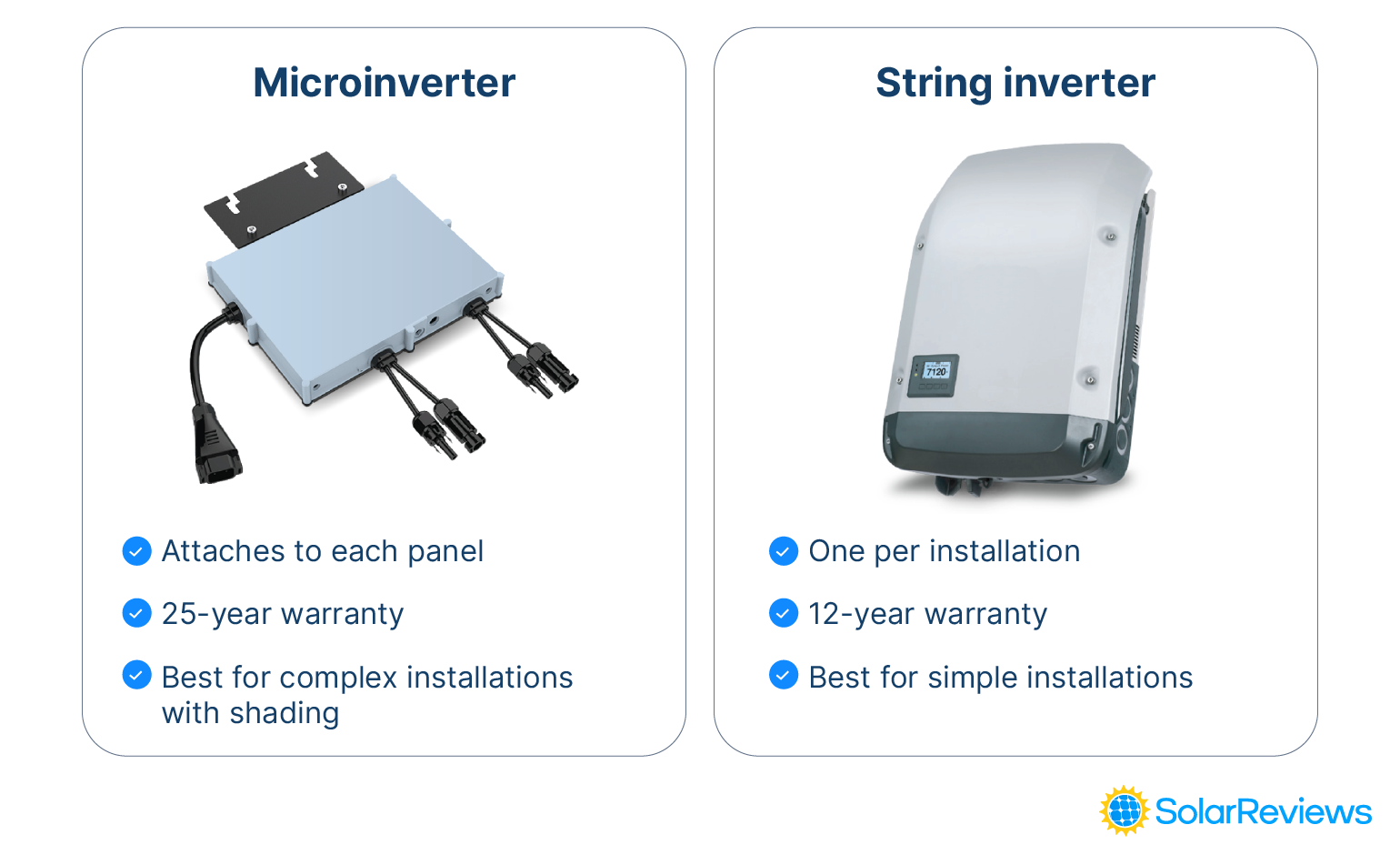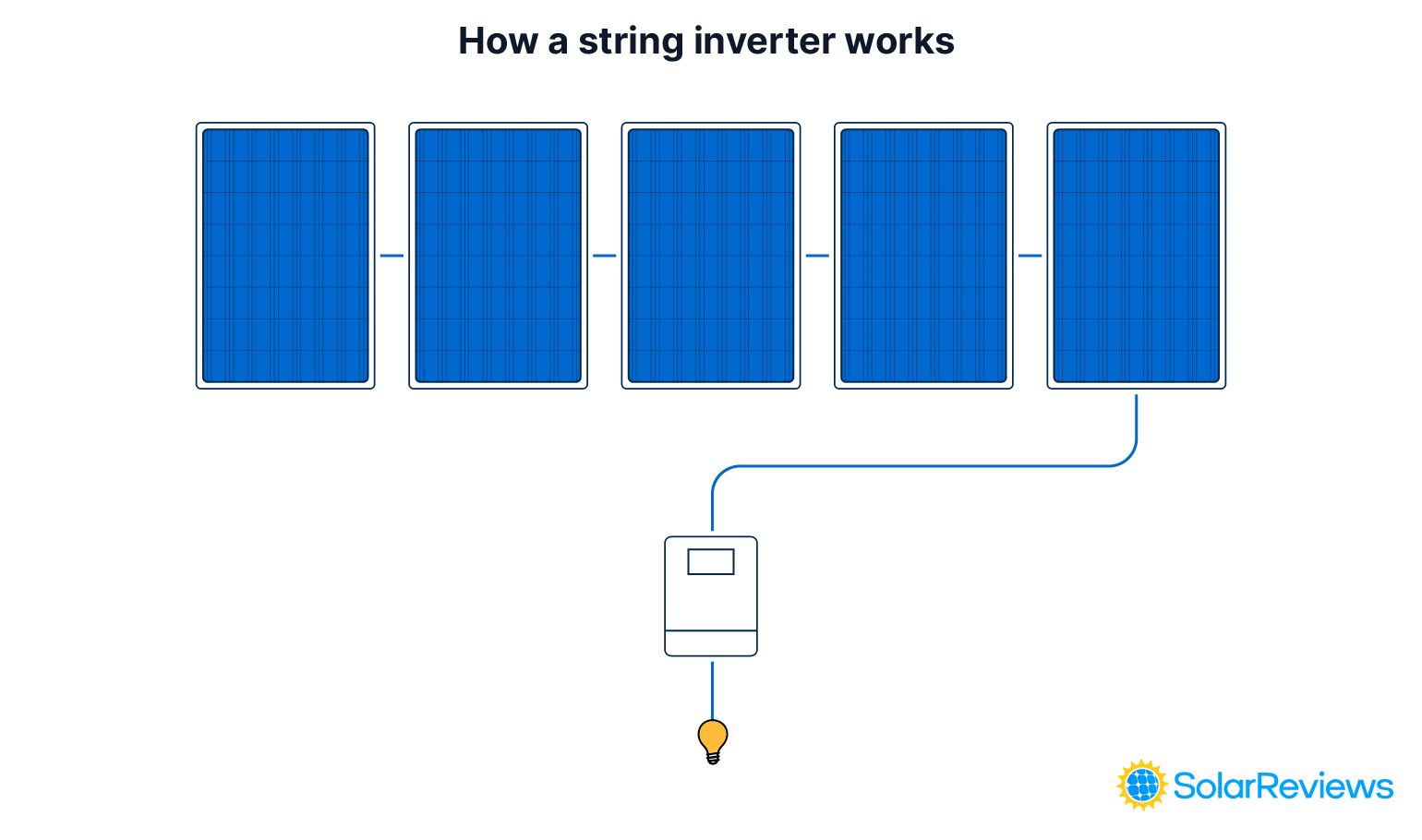Updated 8 months ago
Best Solar Panel Inverters: Microinverter vs. String Inverters
Written by
Jamie Smith

Find reliable solar contractors to find the best solar inverter for your roof
Solar panel inverters are the unsung heroes of residential solar panel systems. Aside from the solar panels themselves, solar inverters are one of the most important components of a solar installation.
At their core, solar inverters have one main function: to convert the direct current (DC) electricity that your solar panels generate into an alternating current (AC) electricity that your home can use. There are two main types of solar inverters:
Microinverters
String inverters
There are advantages and disadvantages to each type of solar inverter, and the right one for your home ultimately depends on your system design.
Key takeaways
-
Solar inverters convert DC electricity produced by solar panels and turn it into AC electricity that homes and appliances can use.
-
There are two main types of solar inverters for homes: microinverters and string inverters
-
Microinverters attach to the back of a solar panel and convert from AC to DC on your roof.
-
String inverters are wired to strings of solar panels, with one string inverter installed on the side of your home.
-
Microinverters are best for complex solar installations that are on multiple sides of a roof or that will experience shading, while string inverters are best for simple installations.
What do solar inverters do?
Solar inverters are a crucial component of a solar energy system. A solar inverter’s primary purpose is to convert the DC electricity generated by your solar panels into AC electricity, which can be used to power your home.
Solar inverters can also maximize your solar energy production, monitor system output, communicate with the utility grid, and detect any faults in your system.
Solar inverter types: Microinverter vs. string inverters

There are two main types of solar inverters used in home solar installations: Microinverters and string inverters.
Both inverter types have the same essential function of converting solar power into usable electricity, but how they get it done is a bit different.
What are hybrid inverters? Solar systems paired with battery storage may use a hybrid inverter that connects the panels, solar battery, electrical grid, and home together in one unit. Hybrid inverters are efficient and allow for a more streamlined design. However, lots of solar batteries on the market now have built-in inverters.
What are microinverters?

A microinverter works by attaching to the back of each individual solar panel and is responsible for converting the DC power produced by that specific panel into AC power. Some microinverters can connect to more than one solar panel.
After the electricity is converted, the microinverter sends AC electricity from each solar panel directly to the home’s electrical circuits or the electrical grid.
Microinverters are best for solar systems that will experience shading or are installed on more complex roofs. If you think you’ll want to expand your solar panel system someday, then microinverters are also a good choice, as they make it easier to add solar panels. The most popular brand of microinverters is Enphase.
Pros
-
Individual panel performance doesn’t impact others
-
Built-in panel monitoring capabilities
-
Easy for system expansion
-
Meets rapid shut-down requirements
-
25-year warranty
Cons
-
Difficult to repair
-
Expensive
-
More points of failure
What are string inverters?

String inverters also turn DC into AC electricity, but do so differently than a microinverter. Typically, only one string inverter is installed for a residential solar installation, which is usually installed close to your main service panel or electrical meter.
The solar panels on your roof will be wired in strings connected to the string inverter, where the electricity generated by your solar panels will be converted for your home to use.
String inverters are often paired with DC power optimizers to meet electrical code standards, maximize energy production, and reduce shading impacts. Power optimizers are attached to the back of each panel, track the panel’s output, and can then regulate voltage before the generated power is sent to the string inverter.
String inverters are best for solar installations on simple, unshaded roofs. SolarEdge is one of the most popular string inverter brands.
Pros
-
Low cost
-
Simple design
-
Easy to troubleshoot
Cons
-
Inverter errors impact entire solar system
-
Difficult for system expansion
-
Additional equipment needed for rapid shut-down requirements
-
Short lifespan
5 best solar panel inverter brands
According to the 2025 SolarReviews Solar Industry Survey, the top inverter brands used the most by installers are:
Enphase
SolarEdge
Tesla
SolarArk
SMA
This is the third year in a row that Enphase and SolarEdge appeared on our list for top inverter brands, proving to be a consistent brand trusted by installers year after year. A more surprising contender on this list is Tesla’s inverter. According to our survey, the number of respondents who installed Tesla inverters has more than doubled from the previous year.
Which type of inverter is best for solar panels?
The right inverter for you ultimately depends on your home and the type of solar installation you get.
Microinverters are the best choice for bigger, more complex systems, like having panels on more than one roof plane. Also, if your panels receive partial shade throughout the day, a microinverter will help make the most of your system’s performance. Even at a higher price point, maximizing solar power production will help you see a return on investment.
String inverters are ideal for straightforward installations, like when you have a shade-free roof with all the panels placed on one side. Having the DC optimizers helps you maximize your panel’s power production, but you can still enjoy the ease of just having one inverter at a lower price point.
Solar panel inverters: FAQs
Jamie is a Content Writer and researcher at SolarReviews. A recent graduate of La Salle University in Philadelphia, Jamie earned her B.S. in communications with a concentration in journalism, mass media, and public relations. Jamie has previously worked at a marketing company where she had the opportunity to highlight and promote small business owners through long-form stories and interviews. With a deep-rooted passion for creativity, Jamie stri...
Learn more about Jamie Smith